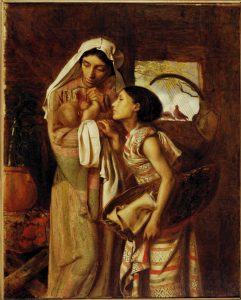April 19 - 27, 2019 - Passover
Passover (called Pesach in Hebrew) is a Jewish holiday. Passover takes place in early spring during the Jewish calendar month of Nissan, starting at sundown on the fourteenth day, until the twenty-first day at sundown. This corresponds to sundown on Friday, April 19 through sundown on Saturday, April 27, in 2019.
Passover commemorates the story of the Israelites’ exodus from ancient Egypt. This story appears in the Torah in the Books of Exodus, Numbers, and Deuteronomy. Here, we will include a brief summary, but you can find more specific details about the story in this item:
In ancient Egypt, the Pharoah, who is the ruler of Egypt, is fearful that there are too many Jews living in Egypt, and that one day they will outnumber Egyptian people. So, he decided to enslave the Jewish people and ordered that all first born Jewish males must be killed. One the mothers sent her baby down the Nile in a basket, instead of killing him. The Pharaoh’s daughter found that baby, adopted him, and named him Moses. When Moses is older, he learns that he is Jewish, and becomes aware of the Egyptians’ mistreatment of the Jewish people.
He ends up killing an Egyptian slave master, and flees to the desert, where he lives as a shepherd for 40 years. One day, G-d appears to Moses and tells him to go to the Pharaoh and lead the Jews out of slavery. So, Moses goes to the Pharaoh and asks if the Jews can be released from their enslaved condition and leave Egypt. Each time the Pharaoh said, “no,” G-d sent a plague down on Egypt (turning the river to blood, boils, hail, locusts, etc.). Finally, the tenth and most horrific plague came, the killing for the first born child by the angel of death. To protect their first-born children, the Israelites marked their doors with lamb’s blood so the angel of death would pass over them. Thus the name Passover, which is “pesach” in Hebrew.
Terrified of what might come next, the Egyptians convince the Pharaoh to release the Jews, and Moses leads them out of Egypt. However, the Pharaoh changes his mind, and sends his soldiers to get the former slaves. The Egyptian army approached the Jews who were fleeing, at the edge of the Red Sea, trapping them. At this point, G-d causes the Red Sea to part, allowing Moses and his followers to cross safely. But G-d closes the passage behind them, drowning the Egyptians who come after. According to the Torah, the Jews travel through the Sinai desert for 40 years before reaching their promised land in Canaan.
Passover is one of the most important Jewish holidays, and is celebrated by many families across the world. One important practice is removing all food products made with yeast from the home, and not eating them during the whole of Passover. Instead of bread, Jews eat a type of flatbread called matzo. This is because the Jews left Egypt in such a hurry that there was no time for their bread to rise.
In addition, on the first two nights of Passover, families and friends gather for a religious feast known as a Seder. During the meal, the story of exodus from Egypt is read aloud from a special text called the Haggadah (Hebrew for “telling”). Rituals corresponding to various aspects of the narrative are performed. For example, vegetables are dipped into salt water representing the tears Jews shed during their time as slaves, and bitter herbs (usually horseradish) symbolizing the unpleasant years of their bondage are eaten.
A Seder plate at the center of the table contains Passover foods. These foods have significance to the exodus story. They include:
- a hard boiled egg, symbolizing the circle of life, and the traditional holiday offering in the days of the Holy Temple
- bitter herbs (often grated horseradish), to represent the bitterness of enslavement
- bitter stem of romaine lettuce, also to symbolize the bitterness of slavery
- vegetables (often parsley), to be dipped in saltwater, representing the tears of the Jews
- charoset, an applesauce-like mixture with wine, nuts, and apples represents the mortar used by the Jews in Egypt
- a lamb shank bone, representing the lamb that was sacrificed to mark the Israelites' houses for the Angel of Death
Other common menu item include matzo kugel, which is a pudding made from matzo and apples, poached fish patties (known as gefilte fish), and chicken soup with matzo balls.
In some families, a piece of matzo, called the afikomen, is hidden early in the evening. The younger members of the family hunt to find it, and the finder is rewarded with a prize or money.
To learn more about the Passover story and traditions check out the items below:
If there's a particular celebration you or someone you know participates in that we missed, let us know by leaving a comment on this post. Or, if you think we got something wrong, please also comment and let us know. We try to be as accurate as possible, but if there's a mistake, we want to correct it.




Add a comment to: The Origins and Practices of Holidays: Passover